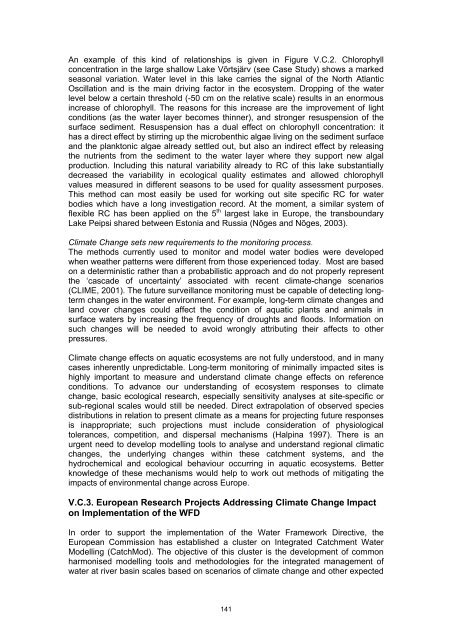Climate Change and the European Water Dimension - Agri ...
Climate Change and the European Water Dimension - Agri ...
Climate Change and the European Water Dimension - Agri ...
Create successful ePaper yourself
Turn your PDF publications into a flip-book with our unique Google optimized e-Paper software.
An example of this kind of relationships is given in Figure V.C.2. Chlorophyll<br />
concentration in <strong>the</strong> large shallow Lake Võrtsjärv (see Case Study) shows a marked<br />
seasonal variation. <strong>Water</strong> level in this lake carries <strong>the</strong> signal of <strong>the</strong> North Atlantic<br />
Oscillation <strong>and</strong> is <strong>the</strong> main driving factor in <strong>the</strong> ecosystem. Dropping of <strong>the</strong> water<br />
level below a certain threshold (-50 cm on <strong>the</strong> relative scale) results in an enormous<br />
increase of chlorophyll. The reasons for this increase are <strong>the</strong> improvement of light<br />
conditions (as <strong>the</strong> water layer becomes thinner), <strong>and</strong> stronger resuspension of <strong>the</strong><br />
surface sediment. Resuspension has a dual effect on chlorophyll concentration: it<br />
has a direct effect by stirring up <strong>the</strong> microbenthic algae living on <strong>the</strong> sediment surface<br />
<strong>and</strong> <strong>the</strong> planktonic algae already settled out, but also an indirect effect by releasing<br />
<strong>the</strong> nutrients from <strong>the</strong> sediment to <strong>the</strong> water layer where <strong>the</strong>y support new algal<br />
production. Including this natural variability already to RC of this lake substantially<br />
decreased <strong>the</strong> variability in ecological quality estimates <strong>and</strong> allowed chlorophyll<br />
values measured in different seasons to be used for quality assessment purposes.<br />
This method can most easily be used for working out site specific RC for water<br />
bodies which have a long investigation record. At <strong>the</strong> moment, a similar system of<br />
flexible RC has been applied on <strong>the</strong> 5 th largest lake in Europe, <strong>the</strong> transboundary<br />
Lake Peipsi shared between Estonia <strong>and</strong> Russia (Nõges <strong>and</strong> Nõges, 2003).<br />
<strong>Climate</strong> <strong>Change</strong> sets new requirements to <strong>the</strong> monitoring process.<br />
The methods currently used to monitor <strong>and</strong> model water bodies were developed<br />
when wea<strong>the</strong>r patterns were different from those experienced today. Most are based<br />
on a deterministic ra<strong>the</strong>r than a probabilistic approach <strong>and</strong> do not properly represent<br />
<strong>the</strong> ‘cascade of uncertainty’ associated with recent climate-change scenarios<br />
(CLIME, 2001). The future surveillance monitoring must be capable of detecting longterm<br />
changes in <strong>the</strong> water environment. For example, long-term climate changes <strong>and</strong><br />
l<strong>and</strong> cover changes could affect <strong>the</strong> condition of aquatic plants <strong>and</strong> animals in<br />
surface waters by increasing <strong>the</strong> frequency of droughts <strong>and</strong> floods. Information on<br />
such changes will be needed to avoid wrongly attributing <strong>the</strong>ir affects to o<strong>the</strong>r<br />
pressures.<br />
<strong>Climate</strong> change effects on aquatic ecosystems are not fully understood, <strong>and</strong> in many<br />
cases inherently unpredictable. Long-term monitoring of minimally impacted sites is<br />
highly important to measure <strong>and</strong> underst<strong>and</strong> climate change effects on reference<br />
conditions. To advance our underst<strong>and</strong>ing of ecosystem responses to climate<br />
change, basic ecological research, especially sensitivity analyses at site-specific or<br />
sub-regional scales would still be needed. Direct extrapolation of observed species<br />
distributions in relation to present climate as a means for projecting future responses<br />
is inappropriate; such projections must include consideration of physiological<br />
tolerances, competition, <strong>and</strong> dispersal mechanisms (Halpina 1997). There is an<br />
urgent need to develop modelling tools to analyse <strong>and</strong> underst<strong>and</strong> regional climatic<br />
changes, <strong>the</strong> underlying changes within <strong>the</strong>se catchment systems, <strong>and</strong> <strong>the</strong><br />
hydrochemical <strong>and</strong> ecological behaviour occurring in aquatic ecosystems. Better<br />
knowledge of <strong>the</strong>se mechanisms would help to work out methods of mitigating <strong>the</strong><br />
impacts of environmental change across Europe.<br />
V.C.3. <strong>European</strong> Research Projects Addressing <strong>Climate</strong> <strong>Change</strong> Impact<br />
on Implementation of <strong>the</strong> WFD<br />
In order to support <strong>the</strong> implementation of <strong>the</strong> <strong>Water</strong> Framework Directive, <strong>the</strong><br />
<strong>European</strong> Commission has established a cluster on Integrated Catchment <strong>Water</strong><br />
Modelling (CatchMod). The objective of this cluster is <strong>the</strong> development of common<br />
harmonised modelling tools <strong>and</strong> methodologies for <strong>the</strong> integrated management of<br />
water at river basin scales based on scenarios of climate change <strong>and</strong> o<strong>the</strong>r expected<br />
141













